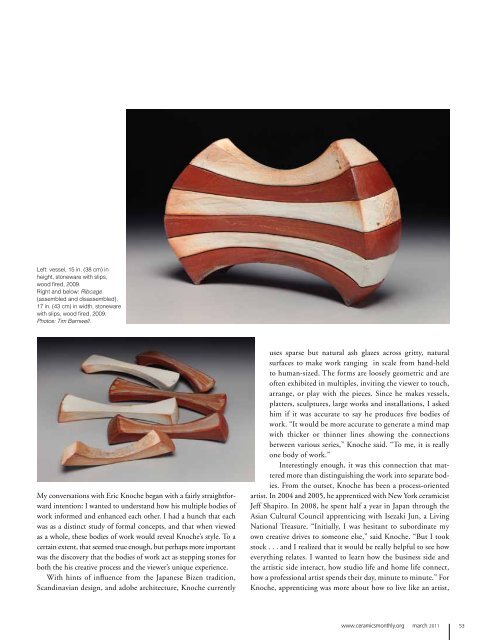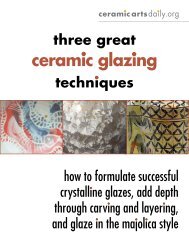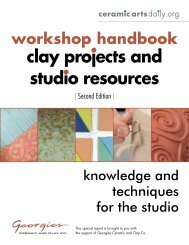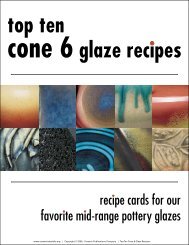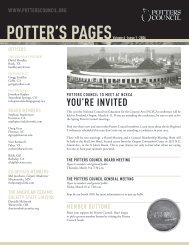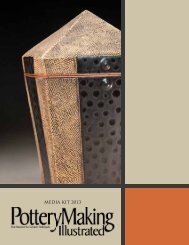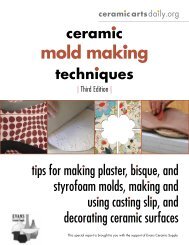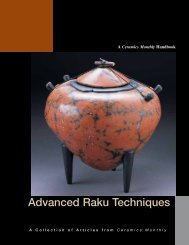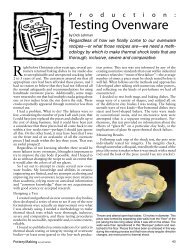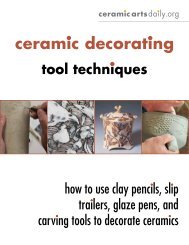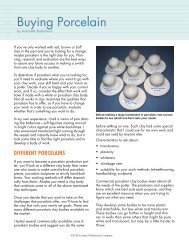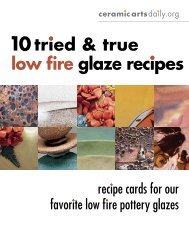Spotlight: Nick Joerling shifts gears Techno File - Ceramic Arts Daily
Spotlight: Nick Joerling shifts gears Techno File - Ceramic Arts Daily
Spotlight: Nick Joerling shifts gears Techno File - Ceramic Arts Daily
Create successful ePaper yourself
Turn your PDF publications into a flip-book with our unique Google optimized e-Paper software.
Left: vessel, 15 in. (38 cm) in<br />
height, stoneware with slips,<br />
wood fired, 2009.<br />
Right and below: Ribcage<br />
(assembled and disassembled),<br />
17 in. (43 cm) in width, stoneware<br />
with slips, wood fired, 2009.<br />
Photos: Tim Barnwell.<br />
My conversations with Eric Knoche began with a fairly straightforward<br />
intention: I wanted to understand how his multiple bodies of<br />
work informed and enhanced each other. I had a hunch that each<br />
was as a distinct study of formal concepts, and that when viewed<br />
as a whole, these bodies of work would reveal Knoche’s style. To a<br />
certain extent, that seemed true enough, but perhaps more important<br />
was the discovery that the bodies of work act as stepping stones for<br />
both the his creative process and the viewer’s unique experience.<br />
With hints of influence from the Japanese Bizen tradition,<br />
Scandinavian design, and adobe architecture, Knoche currently<br />
uses sparse but natural ash glazes across gritty, natural<br />
surfaces to make work ranging in scale from hand-held<br />
to human-sized. The forms are loosely geometric and are<br />
often exhibited in multiples, inviting the viewer to touch,<br />
arrange, or play with the pieces. Since he makes vessels,<br />
platters, sculptures, large works and installations, I asked<br />
him if it was accurate to say he produces five bodies of<br />
work. “It would be more accurate to generate a mind map<br />
with thicker or thinner lines showing the connections<br />
between various series,” Knoche said. “To me, it is really<br />
one body of work.”<br />
Interestingly enough, it was this connection that mattered<br />
more than distinguishing the work into separate bodies.<br />
From the outset, Knoche has been a process-oriented<br />
artist. In 2004 and 2005, he apprenticed with New York ceramicist<br />
Jeff Shapiro. In 2008, he spent half a year in Japan through the<br />
Asian Cultural Council apprenticing with Isezaki Jun, a Living<br />
National Treasure. “Initially, I was hesitant to subordinate my<br />
own creative drives to someone else,” said Knoche. “But I took<br />
stock . . . and I realized that it would be really helpful to see how<br />
everything relates. I wanted to learn how the business side and<br />
the artistic side interact, how studio life and home life connect,<br />
how a professional artist spends their day, minute to minute.” For<br />
Knoche, apprenticing was more about how to live like an artist,<br />
www.ceramicsmonthly.org march 2011 53


